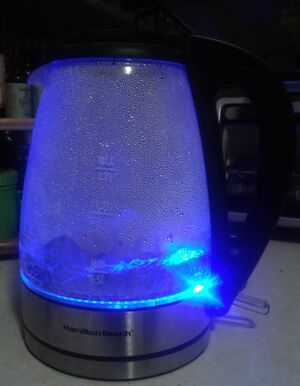Hamilton Beach/model 40865
About
The Hamilton Beach model 40865, also labeled "TYPE K39", is an electric teakettle with a glass main body and blue LED lighting.
Features:
- 1500 watts
- 1.7 liter capacity
- automatically switches off when boiling
- "scorch protection" when water gets low
It is sold in the US for about $40 list price and $30-$35 retail price (e.g. Target).
Repair
This model can mostly be repaired without special tools. The base has six screws in two rings (3 screws each); the outer ring contains one triangle-head screw, but this can be removed by using a flat-head screwdriver of just the right width to fit inside one edge of the triangle. All of the other screws are crosshatch.
The base-cover can be a little difficult to remove (and replace) because it gets caught on the handle a bit; some minor forcing appears to be necessary (but not the "when it sounds/feels like you're breaking it, you're doing it right" level of force necessary with many cellphones and laptops).
The power-interface unit can be a little difficult to remove as the screws (standard crosshatch) are very tight; I had to use a vise-grip wrench to loosen them before I could get the crosshatch driver to engage.
The least repairable part of this model is the heating element, which appears to be bonded to the glass and the round metal plate inside that. If the glass breaks, the heating element cannot be separated from it[1], and it's necessary to cut its two wires in order to separate the rest of the electrical pieces.
Ways in which this unit can break include:
- switch won't stay on: the external plastic piece probably just needs reseating within the switch/power-interface mechanism
- switch goes on, but no light or heat: the base may not be seated properly. If the base cover has been removed, it may not have been put back together quite right; it's a bit fussy. The visible piece of the power-interface assembly needs to be completely flush with the base cover, and the base cover needs to be completely flush with the surrounding ring.
Links
Reference
- ↑ It's conceivable that this might be possible with special equipment or solvents, depending on how these pieces are bonded.

